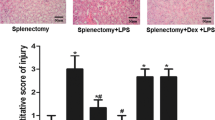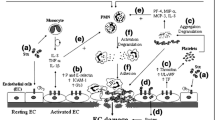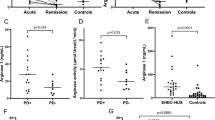Abstract
The role of proinflammatory cytokines in a rat model of toxin-induced hemolytic uremic syndrome (HUS) was studied. Male Sprague-Dawley rats underwent continuous saline infusion (6 ml/h) via a tail vein and received a bolus injection of saline (control), lipopolysaccharide (LPS, 10 μg/100 g body weight), ricin (6.7 μg/100 g body weight), or ricin with LPS (ricin+LPS). They were then observed for 8 h. Blood samples and kidney tissues were obtained at the end of the experiment. The effects of FR 167653, a potent inhibitor of interleukin-1β (IL-1β) and tumor necrosis factor-α (TNF-α) production, were also examined in ricin+LPS-treated rats. Only ricin+LPS-treated rats developed significant thrombocytopenia, hemolysis, and oliguric acute renal failure with extensive glomerular thrombotic microangiopathy, which was characterized by glomerular microthrombi and apoptosis of glomerular endothelial cells. Thrombotic microangiopathy was not detected in other organs, including the brain, liver, spleen, pancreas, lung, colon, and intestine. Significantly elevated levels of serum IL-1β and TNF-α were detected only in ricin+LPS-treated rats. Treatment of ricin+LPS-treated rats with FR 167653 significantly reduced the serum levels of IL-1β and TNF-α, accompanied by improvement of the oliguric renal failure and glomerular thrombotic microangiopathy. These findings indicate that the increased serum levels of IL-1β and TNF-α, which probably result in the apoptosis of glomerular endothelial cells, play a pivotal role in the development of this rat model of toxin-induced HUS. The findings also suggest that inhibition of these proinflammatory cytokines may prevent the development of HUS.




Similar content being viewed by others
References
Koster F, Levin J, Walker L, Tung KSK, Gilman RH, Rahaman MM, Majid MA, Islam S, Williams RC (1978) Hemolytic-uremic syndrome after shigellosis. Relation to endotoxemia and circulating immune complexes. N Engl J Med 298:927–933
Bitzan M, Moebius E, Ludwig K, Müller-Wiefel DE, Heesemann J, Karch H (1991) High incidence of serum antibodies to Escherichia coli O157 lipopolysaccharide in children with hemolytic-uremic syndrome. J Pediatr 119:380–385
Siegler RL (1995) The hemolytic uremic syndrome. Pediatr Clin North Am 42:1505–1529
Lopez EL, Contrini MM, Devoto S, De Rosa MF, Grana MG, Genero MH, Canepa C, Gomez HF, Cleary TG (1995) Tumor necrosis factor concentrations in hemolytic uremic syndrome patients and children with bloody diarrhea in Argentina. Pediatr Infect Dis J 14:594–598
Taylor CM, Williams JM, Lote CJ, Howie AJ, Thewles A, Wood JA, Milford DV, Raafat F, Chant I, Rose PE (1999) A laboratory model of toxin-induced haemolytic uraemic syndrome. Kidney Int 55:1367–1374
Licastro F, Morini MC, Bolognesi A, Stirpe F (1993) Ricin induces the production of tumour necrosis factor-alpha and interleukin-1 beta by human peripheral-blood mononuclear cells. Biochem J 294:517–520
Taylor FB Jr, Tesh VL, DeBault L, Li A, Chang AC, Kosanke SD, Pysher TJ, Siegler RL (1999) Characterization of the baboon responses to Shiga-like toxin: descriptive study of a new primate model of toxic responses to Stx-1. Am J Pathol 154:1285–1299
Hughes AK, Stricklett PK, Kohan DE (1998) Shiga toxin-1 regulation of cytokine production by human proximal tubule cells. Kidney Int 54:1093–1106
Hughes AK, Stricklett PK, Kohan DE (2001) Shiga toxin-1 regulation of cytokine production by human glomerular epithelial cells. Nephron 88:14–23
Raingeaud J, Gupta S, Rogers JS, Dickens M, Han J, Ulevitch RJ, Davis RJ (1995) Pro-inflammatory cytokines and environmental stress cause p38 mitogen-activated protein kinase activation by dual phosphorylation on tyrosine and threonine. J Biol Chem 270:7420–7426
Lee JC, Badger AM, Griswold DE, Dunnington D, Truneh A, Votta B, White JR, Young PR, Bender PE (1993) Bicyclic imidazoles as a novel class of cytokine biosynthesis inhibitors. Ann N Y Acad Sci 696:149–170
Cuenda A, Rouse J, Doza YN, Meier R, Cohen P, Gallagher TF, Young PR, Lee JC (1995) SB 203580 is a specific inhibitor of a MAP kinase homologue which is stimulated by cellular stresses and interleukin-1. FEBS Lett 364:229–233
Karnitz LM, Abraham RT (1995) Cytokine receptor signaling mechanisms. Curr Opin Immunol 7:320–326
Lee JC, Laydon JT, McDonnell PC, Gallagher TF, Kumar S, Green D, McNulty D, Blumenthal MJ, Heys JR, Landvatter SW (1994) A protein kinase involved in the regulation of inflammatory cytokine biosynthesis. Nature 372:739–746
Badger AM, Bradbeer JN, Votta B, Lee JC, Adams JL, Griswold DE (1996) Pharmacological profile of SB 203580, a selective inhibitor of cytokine suppressive binding protein/p38 kinase, in animal models of arthritis, bone resorption, endotoxin shock and immune function. J Pharmacol Exp Ther 279:1453–1461
Jackson JR, Bolognese B, Hillegass L, Kassis S, Adams J, Griswold DE, Winkler JD (1998) Pharmacological effects of SB 220025, a selective inhibitor of P38 mitogen-activated protein kinase, in angiogenesis and chronic inflammatory disease models. J Pharmacol Exp Ther 284:687–692
Takahashi S, Shigeta J, Inoue H, Tanabe T, Okabe S (1998) Localization of cyclooxygenase-2 and regulation of its mRNA expression in gastric ulcers in rats. Am J Physiol 275:G1137–G1145
Kawano T, Ogushi F, Tani K, Endo T, Ohmoto Y, Hayashi Y, Sone S (1999) Comparison of suppressive effects of a new anti-inflammatory compound, FR167653, on production of PGE2 and inflammatory cytokines, human monocytes, and alveolar macrophages in response to endotoxin. J Leukoc Biol 65:80–86
Wadsworth SA, Cavender DE, Beers SA, Lalan P, Schafer PH, Malloy EA, Wu W, Fahmy B, Olini GC, Davis JE, Pellegrino-Gensey JL, Wachter MP, Siekierka JJ (1999) RWJ 67657, a potent, orally active inhibitor of p38 mitogen-activated protein kinase. J Pharmacol Exp Ther 291:680–687
Takahashi S, Keto Y, Fujita T, Uchiyama T, Yamamoto A (2001) FR167653, a p38 mitogen-activated protein kinase inhibitor, prevents Helicobacter pylori-induced gastritis in Mongolian gerbils. J Pharmacol Exp Ther 296:48–56
Wada T, Furuichi K, Sakai N, Hisada Y, Kobayashi K, Mukaida N, Tomosugi N, Matsushima K, Yokoyama H (2001) Involvement of p38 mitogen-activated protein kinase followed by chemokine expression in crescentic glomerulonephritis. Am J Kidney Dis 38:1169–1177
Naruse I, Keino H, Kawarada Y (1994) Antibody against single-stranded DNA detects both programmed cell death and drug-induced apoptosis. Histochemistry 101:73–78
Frankfurt OS, Robb JA, Sugarbaker EV, Villa L (1996) Monoclonal antibody to single-stranded DNA is a specific and sensitive cellular marker of apoptosis. Exp Cell Res 226:387–397
Watanabe I, Toyoda M, Okuda J, Tenjo T, Tanaka K, Yamamoto T, Kawasaki H, Sugiyama T, Kawarada Y, Tanigawa N (1999) Detection of apoptotic cells in human colorectal cancer by two different in situ methods: antibody against single-stranded DNA and terminal deoxynucleotidyl transferase-mediated dUTP-biotin nick end-labeling (TUNEL) methods. Jpn J Cancer Res 90:188–193
Ostendorf T, Kunter U, Eitner F, Loos A, Regele H, Kerjaschki D, Henninger DD, Janjic N, Floege J (1999) VEGF165 mediates glomerular endothelial repair. J Clin Invest 104:913–923
Dawson-Saunders B, Trapp RG (1999) Comparing three or more means. In: Basic and clinical biostatistics, Appleton and Lange, Norwalk, pp 124–141
Tesh VL, Samuel JE, Perera LP, Sharefkin JB, O’Brien-AD (1991) Evaluation of the role of Shiga and Shiga-like toxins in mediating direct damage to human vascular endothelial cells. J Infect Dis 164:344–352
Louise CB, Obrig TG (1992) Shiga toxin-associated hemolytic uremic syndrome: combined cytotoxic effects of shiga toxin and lipopolysaccharide (endotoxin) on human vascular endothelial cells in vitro. Infect Immun 60:1536–1543
Barrett TJ, Potter ME, Wachsmuth IK (1989) Bacterial endotoxin both enhances and inhibits the toxicity of Shiga-like toxin II in rabbits and mice. Infect Immun 57:3434–3437
Richardson SE, Karmali MA, Becker LE, Smith CR (1988) The histopathology of the hemolytic uremic syndrome associated with verocytotoxin-producing Escherichia coli infections. Hum Pathol 19:1102–1108
Inward CD, Williams J, Chant I, Crocker J, Milford DV, Rose PE, Taylor CM (1995) Verocytotoxin-1 induces apoptosis in vero cells. J Infect 30:213–218
Mangeney M, Lingwood CA, Taga S, Caillou B, Tursz T, Wiels J (1993) Apoptosis induced in Burkitt’s lymphoma cells via Gb3/CD77, a glycolipid antigen. Cancer Res 53:5314–5319
Sandvig K, Deurs B van (1992) Toxin-induced cell lysis: protection by 3-methyladenine and cycloheximide. Exp Cell Res 200:253–262
Taguchi T, Uchida H, Kiyokawa N, Mori T, Sato N, Horie H, Takeda T, Fujimoto J (1998) Verotoxins induce apoptosis in human renal tubular epithelium derived cells. Kidney Int 53:1681–1688
Pijpers AH, Setten PA van, Heuvel LP van den, Assmann KJ, Dijkman HB, Pennings AH, Monnens LA, Hinsbergh VW van (2001) Verocytotoxin-induced apoptosis of human microvascular endothelial cells. J Am Soc Nephrol 12:767–778
Karpman D, Hakansson A, Perez MT, Isaksson C, Carleman E, Caprioli A, Svanborg C (1998) Apoptosis of renal cortical cells in the hemolytic-uremic syndrome: in vivo and in vitro studies. Infect Immun 66:636–644
Oda T, Komatsu N, Muramatsu T (1997) Cell lysis induced by ricin D and ricin E in various cell lines. Biosci Biotechnol Biochem 61:291–297
Baluna R, Coleman E, Jones C, Ghetie V, Vitetta ES (2000) The effect of a monoclonal antibody coupled to ricin A chain-derived peptides on endothelial cells in vitro: insights into toxin-mediated vascular damage. Exp Cell Res 258:417–424
Inward CD, Howie AJ, Fitzpatrick MM, Raffat F, Milford DV, Taylor MC (1997) Renal histopathology in fatal cases of diarrhoea-associated haemolytic uraemic syndrome. Pediatr Nephrol 11:556–559
Bohle A, Grabensee B, Fisher R, Berg E, Klust H (1985) On four cases of hemolytic-uremic syndrome without microangiopathy. Clin Nephrol 24:88–92
Kaplan BS, Proesmans W (1987) The hemolytic uremic syndrome of childhood and its variants. Semin Hematol 24:148–160
Acknowledgements
This study was supported by a grant from The Mother and Child Health Foundation (to Dr. Iijima), a grant from The Study Group for Renal Anemia (to Dr. Iijima), and a grant from the Hyogo Prefecture Health Promotion Association (to Dr. Iijima). The authors are grateful to Miss K. Nishimoto for her technical assistance.
Author information
Authors and Affiliations
Corresponding author
Rights and permissions
About this article
Cite this article
Fu, X.J., Iijima, K., Nozu, K. et al. Role of p38 MAP kinase pathway in a toxin-induced model of hemolytic uremic syndrome. Pediatr Nephrol 19, 844–852 (2004). https://doi.org/10.1007/s00467-004-1502-4
Received:
Revised:
Accepted:
Published:
Issue Date:
DOI: https://doi.org/10.1007/s00467-004-1502-4




